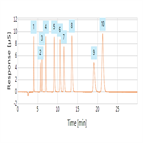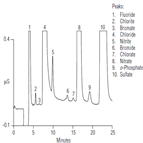Find methods for your needs
Refine by Feature
Displaying 1-3 of 3 results for Tag: Oxyhalides
Dionex IonPac AS23-4µm Column Performance Test Using its QAR Method
Instrument Type: ICBefore running any samples, Thermo Scientific recommends that you first confirm the performance of the column by reproducing the lot validation report chromatogram shipped with column. Compare your results with the one reported in the quality assurance report. This record provides an eWorkflow for executing the QAR method on an Integrion HPIC system.
AN81: Ion Chromatographic Determination of Oxyhalides and Bromide at Trace Level Concentrations in Drinking Water Using Direct Injection.
Instrument Type: ICThis Application Note describes the use of IonPac AS9-HC column to determine trace levels of oxyhalides and bromide in the presence of common anions in drinking water, as well as their detection limits and linear concentration ranges. Unlike previous IC methods for these ions, no pretreatment cartridges are required to remove high concentrations of common ions such as chloride, bicarbonate, and sulfate. The instrumentation, techniques, and representative applications of this method are discussed in this Note. Also refer to AN167 and AN184 for updated methods.
AN149: Determination of Chlorite, Bromate, Bromide, and Chlorate in Drinking Water by Ion Chromatography with an On-Line-Generated Postcolumn Reagent.
Instrument Type: ICThis application note describes an improved ion chromatography (IC) method to quantify oxyhalide DBP anions and bromide at low concentration levels in reagent water, bottled water, and finished drinking water using an approach that is technically equivalent to U.S. EPA Method 326.0. The oxyhalide anions chlorite, chlorate, bromide, and bromate are separated on a Thermo Scientific Dionex IonPac AS9-HC column and measured by using suppressed conductivity detection (as in EPA Method 300.1), followed by postcolumn reaction (PCR) to enhance detection of bromate.



